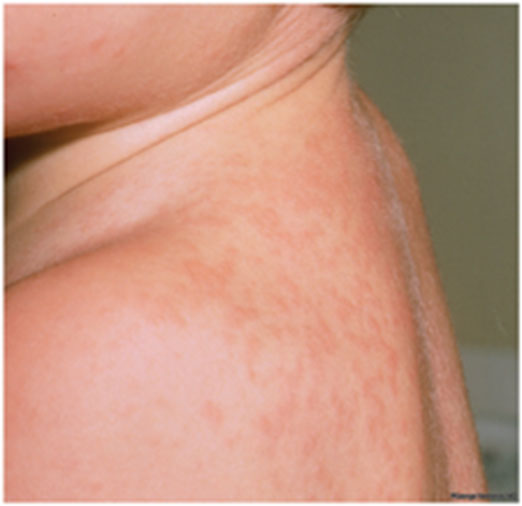By: Raegan Hunt, MD, PhD, FAAP, FAAD & Matthew Mahoney, DO
Roseola is a very common viral illness in infants and young children. It causes high fevers for 3 to 5 days followed by a pink, splotchy rash. While this can be scary for parents, it usually goes away quickly without any specific treatment.
What causes roseola?
Roseola (also known as sixth disease, exanthem subitum or roseola infantum) is caused by a virus, typically human herpesvirus 6 (HHV-6). This common viral infection mostly affects young children between 6 months to 2 years old. Research has shown that almost all children get sick with roseola sometime in the first 2 years of their life.
What are the signs and symptoms of roseola?
Sudden fever followed by a rash
 Infants and children with roseola have two main symptoms: a fever and rash. Often the fever seen is between 102 degrees Fahrenheit and 105 degrees Fahrenheit (38.9 and 40.5 degrees Celsius) and lasts for 3 to 5 days.
Infants and children with roseola have two main symptoms: a fever and rash. Often the fever seen is between 102 degrees Fahrenheit and 105 degrees Fahrenheit (38.9 and 40.5 degrees Celsius) and lasts for 3 to 5 days.
Just as the fever goes away, a splotchy rash appears on the chest, stomach and back, then spreads to the neck, arms and legs. In children with lighter skin tones, the rash is usually pink or red in color. In children with darker skin tones, the rash may be more difficult to see and a faint red or purple color.
The roseola rash is usually not itchy and disappears on its own in 1 to 4 days.
Other possible symptoms
Despite the fever and rash, most children with roseola do not seem very sick and are active and playful. Some children may develop additional symptoms such as fussiness, runny nose, cough, vomiting or diarrhea.
How is roseola diagnosed?
Most of the time, your child's doctor can diagnose roseola by hearing about the symptoms and looking at the rash if it has developed. Laboratory tests are not very useful.
How is roseola treated?
There is no specific treatment for roseola. Acetaminophen and ibuprofen help lower your child's fever. It is good to encourage your child to drink a lot of fluids to avoid dehydration even if they aren't very hungry. The roseola infection should get better on its own.
Is roseola contagious?
Yes, it is. Since roseola is caused by a virus that can spread through coughing and sneezing, there is a risk that your child could spread the virus to others. Once your child is without a fever for 24 hours, they can return to daycare or school, even if the rash is still present.
When should I call the pediatrician?
If your child is very sleepy and not easily awakened, call for assistance right away. If your child is not drinking and not having wet diapers frequently, contact your pediatrician. If the rash develops into blisters or sores or is affecting the lips and inside the mouth, it is also important to contact your doctor for more guidance.
More information
About Dr. Hunt
 Raegan Hunt, MD, PhD, FAAP, FAAD, is Division Chief of Pediatric Dermatology at Texas Children's Hospital and Associate Professor of Pediatrics and Dermatology at Baylor College of Medicine in Houston, Texas. She is a member of the American Academy of Pediatrics Section on Dermatology Executive Committee and Dermatology Education Committee. Raegan Hunt, MD, PhD, FAAP, FAAD, is Division Chief of Pediatric Dermatology at Texas Children's Hospital and Associate Professor of Pediatrics and Dermatology at Baylor College of Medicine in Houston, Texas. She is a member of the American Academy of Pediatrics Section on Dermatology Executive Committee and Dermatology Education Committee.
|
About Dr. Mahoney
 Matthew Mahoney, DO, is currently a pediatric resident physician at the University of Minnesota and M Health Fairview Masonic Children's Hospital. After completing training in pediatrics, he will continue with residency in dermatology, also at the University of Minnesota. His clinical interests include pediatric dermatology, patient and family education, and improving the ways physicians share unexpected news. He is a member of the American Academy of Pediatrics Section on Dermatology Education Committee. Matthew Mahoney, DO, is currently a pediatric resident physician at the University of Minnesota and M Health Fairview Masonic Children's Hospital. After completing training in pediatrics, he will continue with residency in dermatology, also at the University of Minnesota. His clinical interests include pediatric dermatology, patient and family education, and improving the ways physicians share unexpected news. He is a member of the American Academy of Pediatrics Section on Dermatology Education Committee.
|
Photo credit: George Nankervis, MD/Managing Infectious Diseases in Child Care and Schools: A Quick Reference Guide (American Academy of Pediatrics)